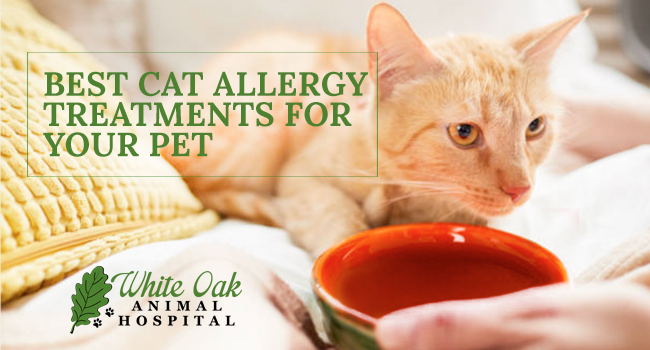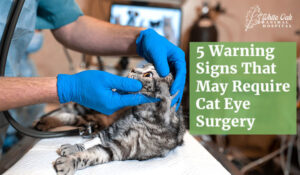
Once your veterinarian confirms your pet’s cat allergy diagnosis, work together on a treatment plan.
Severe allergies may require medical treatment such as steroids.
However, most allergies can be treated with natural or at-home remedies.
Treatments For Cat Allergies
To treat cat allergies, decrease allergen exposure, control fleas, and make necessary dietary changes.
To address secondary infections:
- Antibiotics treat bacterial infections
- Anti-fungals treat yeast infections
- Treat ear infections with regular cleaning and proper medication
To reduce skin allergies and itch, use:
- Vinegar/Water Spray
- Genesis Spray
- Oral Steroids
- Cyclosporine Therapy (Atopica)
Medical Treatments For Cat Allergies
Genesis spray is a topical steroid spray prescription available via your veterinarian to curtail itching.
Another steroid, Prednisone is a powerful anti-inflammatory drug. Prednisone temporarily blocks the symptoms of allergies.
Antihistamines, such as Benadryl, Claritin or Zyrtec are also effective.
Natural Treatments For Cat Allergies
- Aromatherapy
- Acupuncture
- Herbs (alfalfa, burdock, dandelion root, licorice root, nettle, red clover, and spirulina)
- Hydrotherapy
- Diet Changes
- Osteopathy
- Therapeutic Massage
- Room Ionizer
- Orthomolecular Therapy
Home Remedies
Home remedies are beneficial to cats suffering from allergies.
Use the following remedies as a stand-alone treatment or alongside pharmaceutical drugs to soothe cat allergies and itchy skin.
Apple Cider Vinegar
Adding apple cider vinegar to food can enhance your cat’s stomach acid content, making nutrient digestion more efficient.
Efficient digestion eliminates food intolerance.
Apple cider vinegar can also help maintain your cat’s acid/alkaline balance, improve digestion, act as a urinary system tonic, clear urinary tract infections.
Begin by adding 1⁄4 teaspoon to food twice daily for cats under 12 pounds, or 1⁄2 tsp for cats over 12 lbs.
Gradually increase the amount of vinegar used up to 1/4 teaspoon per 4 pounds of body weight if your cat finds vinegar palatable.
You can also use vinegar topically to treat pustules, hot spots, and other allergic reactions on the skin.
Mix vinegar and water at a ratio of 1⁄2 water to 1⁄2 vinegar, and either spray or dab the mixture onto the problem areas.
If using topically on light-colored cats, you will want to use distilled white vinegar. Apple cider vinegar may darken the fur of white and light colored cats.
Pine Bark Extract
Pine bark extract has excellent antioxidant properties, supports the systems in control of inflammation, and inhibits the release of histamine from mast cells.
Mast cells release histamine, which triggers allergic symptoms such as coughing, sneezing, watery eyes, and scratchy throats when an allergen is present.
Pine bark extract blocks histamine release and decreases the allergic symptoms.
It also helps normalize the immune response by inhibiting Nuclear Factor-Kappa B and lowers the sensitivity level for triggering an immune response.
To give your cat a pine bark extract supplement, read the human dosing recommendations on the label and give 1⁄8 to 1⁄4 the recommended amount to your cat.
Coconut Oil
Coconut oil also helps a cat’s digestive system more easily absorb commercial cat food.
Taken internally, coconut oil also helps with skin conditions and allergies because of its antioxidant effect.
Add a small spoonful at each feeding.
Externally, coconut oil treats ear mites, mange, and the symptoms of dry, itchy skin.
The antioxidant properties of coconut oil soothe allergic sores and broken skin.
Coconut oil also has antibacterial and anti-fungal properties.
Also, it’s not harmful for your cat to lick the coconut oil off his fur or skin.
Food Allergy Treatment: Hypoallergenic Cat Food Diet
Sometimes food allergies are misdiagnosed as skin allergies because both types of allergy symptoms may be the same–itching, scratching, and licking.
Many cats are allergic to plastic food bowls.
If your cat experiences allergy symptoms (especially around the mouth) try metal, glass or ceramic food and water dishes instead of plastic.
A tell-tale sign of food allergies is vomiting.
If you know your cat has food allergies, try a hypoallergenic diet for at least four weeks.
Switching food can be tough with cats because they can be finicky and picky.
Give your cat a homemade diet made mostly of a single protein source, free from additives and preservatives.
Some examples are:
- A diet of all turkey or chicken
- A diet of lamb baby food
- Baby food rice cereal
Energetically Cooling Food Choices for Allergic Cats
You can use Eastern Food Therapy to help your cat feel better.
Create your own recipe using the guidelines below.
Keep the number of ingredients to a minimum.
Choose no more than one (1) source of meat and dairy, two (2) sources of vegetables and fruit, and two (2) sources of grains and beans.
Make sure to use more cooling foods than neutral foods.
For example, if you use a neutral protein, make sure all of the carbohydrates and fats you use are cool.
A nutritionally balanced feline diet contains:
- 75% – 90% Protein – from meat
- 10% – 25% Carbohydrates – from grains, vegetables, and fruit
- A minimum of 2% Fat
Check out PET | TAO’s home-cooked Limited Ingredient Cat Food Recipe.
Powerful Tools for Overcoming Cat Allergy Challenges
There are many quick and easy changes you can make at home to help you give your cat an edge on easing allergy challenges.
- Learn more about cat allergies.
- Switch to a Limited Ingredient Cat Food Recipe. PET | TAO Limited Ingredient Cat Food Recipe is naturally low in foods that stimulate an allergic response.
- Supplement with medicinal mushrooms. PET | TAO Complement Immune Mushroom Blend eases inflammatory response and allergy symptoms.
- Try digestive enzymes and probiotics. PET | TAO’s Harmonize GI boosts gut health and combats food allergens.
- Feed Freeze Dried Lung Treats. According to TCVM, Lung is on the same meridian as the skin. Therefore, lung treats help both breathing and skin allergies. Lung treats support lung and skin similar to a glandular supplement in a “like treats like” fashion.
- Learn more about TCVM Herbal Remedies. Chinese medicine offers many amazing natural solutions for dog allergies Some good examples are:
Get A Phone Consultation With Dr. Damron
Related Posts
-
Most Effective Cat Allergy Remedies
Cat allergy remedies exist to treat a number of allergens. However, knowing the source of…
-
What Every Pet Owner Should Know About Pet Allergies
Whether human or pet, allergies usually prove to be a complicated, and sometimes frustrating, topic.…
-
What Are The Common Types Of Cat Cancer?
Cat cancer is an unfortunately common pet malady. Pets develop cancer for a variety of…
-
The Best Way to Get Rid of Cat Allergies Naturally
Would You Like to Know How to Get Rid of Cat Allergies Naturally? Like people,…









